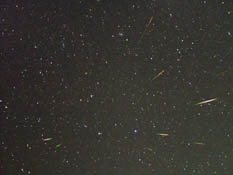
Skygazers worldwide got a treat Sunday as the Leonid meteor shower put on its best display in 35 years. This five-image composite by Kazuyuki Tanaka in Japan shows nine Leonids radiating from the Sickle of Leo (center). The Beehive Cluster is at the top.
The best meteor shower in 35 years sent bright shooting
stars streaking through the sky before dawn Sunday morning for observers
throughout the Americas, the Pacific, and the Far East. Preliminary
reports paint a picture of the much-anticipated 2001 Leonid shower matching
predictions fairly closely. However, the observed rates of a couple
of thousand per hour (as seen by a single observer) fell shy of the
most optimistic predictions of between
7,000 to 15,000 per hour.
In Eastern North America, skywatchers under dark skies
before dawn counted several hundred meteors per hour — an average
of one every 5 or 10 seconds, with occasional spectacular bursts (presumably
by chance) of two or three at once. A crowd of Sky & Telescope
staffers at a lakeshore in Western Massachusetts (under a 6th-magnitude
sky) oohed and aahed at blue, green, and red fireballs radiating from
the cutting edge of the Sickle of Leo, occasionally lighting the ground
with flashes like distant heat lightning. The peak for North America
was predicted to arrive around 10:00 Universal Time (shortly before
dawn in the East), but rates seemed still to be increasing as morning
brightened the sky.
Indeed, observers farther west reported an even more spectacular
show a little later. In Kentucky, David Phillips, a meteor observer
for 15 years, described seeing roughly a meteor per second under an
extremely dark sky. Much of the Midwest was cloudy, but Westerners apparently
had the best of it. The peak probably came around 11:00 UT, according
to Joe Rao, observing with a crowd of 60 at the Skywatcher's Inn in
Arizona. "It was partly cloudy here, with 30 to 70 percent sky obstruction,
but you couldn't look up for more than a second or two without seeing
a meteor, sometimes four at once," said Rao. "These were 1st and 2nd
magnitude. It was the most amazing shower I've seen in over 35 years
of watching the sky."
Observing from Fremont Peak, California, Landon Curt Noll
observed several bursts of activity including a count of more than 1,500
meteors during a 1-hour interval beginning at 10:45 UT, with more than
600 of those appeared in the 15 minutes beginning at 11:00.
Rates seemed to decline somewhat after about 11:15 UT,
but farther west in Hawaii, Stephen J. O'Meara and P. K. Chen were more
than satisfied as the radiant rose high in the sky from about 12:00
to 16:00 UT. "We had an absolutely stunning, remarkable, brilliant and
continuous display of Leonids," writes O'Meara. "The best activity I
have ever seen. Though there was no 'storm' — meaning the sky was
not filled with meteors falling down like rain — the shower did
rain meteors and fireballs for four hours."
The biggest peak was supposed to come around 18:00 UT,
when Australia and the Far East would be turned into view. Rates did
surge again around this time, but judging from early reports, this second
peak was only comparable to the first.
Bradley Schaefer reported from Alice Springs, Australia,
a personal meteor count that peaked with 660 meteors seen during a 15-minute
interval. "They were fast," he writes, "and the bright ones were visible
in various colors, primarily red, green, and yellow."
Sky & Telescope will present full reports in the
coming months as all the data collected worldwide are analyzed.
 0
0
Comments
You must be logged in to post a comment.